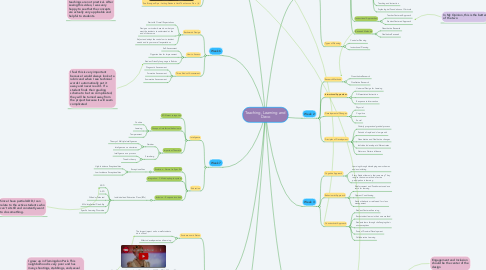
1. Week 5
1.1. Constructivisim
1.1.1. Learning through challenging misconceptions
1.1.2. Problem solving
1.1.3. Inquiry
1.1.4. Critical Thinking
1.1.5. Seeing Multiple Perspectives
1.2. Universal Design for Learning
1.2.1. Multiple Means of Representation
1.2.2. Multiple Means of Action and Expression
1.2.3. Multiple Means of Engagement
1.3. Bloom's Taxonomy
1.3.1. Knowledge
1.3.2. Comprehension
1.3.3. Application
1.3.4. Analysis
1.3.5. Synthesis
1.3.6. Evaluation
1.4. Zoe Branigan-Pipe - Letting Students Hack Their Lesson Plan
2. Week 6
2.1. Backwards Design
2.1.1. Start with Overall Expectations
2.1.2. Design a curriculum based on what you want the students to understand at the end of the course
2.1.3. Adjust and adapt the curriculum to student needs and to your overall expectations
2.2. How to Assess
2.2.1. Self-Assessment
2.2.2. Opportunities for Improvement
2.2.3. Student Friendly Language in Rubrics
2.3. Three Kinds of Assessment
2.3.1. Diagnostic Assesement
2.3.2. Formative Assesement
2.3.3. Summative Assessement
3. Week 7
3.1. Inteligence
3.1.1. 8 Different categories
3.1.2. Groups of intellectual behaviours
3.1.2.1. Conitive
3.1.2.2. Learning
3.1.2.3. Temperament
3.1.3. Important Theorists
3.1.3.1. Gardner
3.1.3.1.1. Theory of Multiple Intelligneces
3.1.3.1.2. Inteligence as a structures
3.1.3.2. Sternberg
3.1.3.2.1. Intelligence as a process
3.1.3.2.2. Triarchic theory
3.2. Education
3.2.1. Evolution - Normal vs Spec Ed
3.2.1.1. Exceptionalities
3.2.1.1.1. High-Incidence Exeptionalities
3.2.1.1.2. Low-Incidence Exceptionalities
3.2.2. Integration - Child adapting to system
3.2.3. Inclusion - Everyone involved
3.2.3.1. Individualized Education Plans (IEPs)
3.2.3.1.1. ADD
3.2.3.1.2. ASD
3.2.3.1.3. Gifted or Talented
3.2.3.1.4. Mild Intellectual Disability
3.2.3.1.5. Specific Learning Disorders
4. Week 8
4.1. Socioeconomic Status
4.1.1. The largest impact on how well students do in school
4.1.2. Affects development and Learning
4.2. Multiculturalism
4.2.1. https://www.youtube.com/watch?time_continue=1110&v=D9Ihs241zeg
4.2.2. Diverse
4.2.3. Everyone Matters
4.2.4. No Discrimination
4.2.5. Inclusion of Aboriginals in Education
4.2.6. Culturally Responsive Teaching
4.2.7. Risks to not being accepting
4.2.7.1. Stereotype Threat
4.2.7.2. Prejudice
4.2.7.3. Offensive
5. Week 9
5.1. Standardized Tests
5.1.1. Grade 3 EQAO
5.1.2. Grade 6 EQAO
5.1.3. Grade 9 EQAO
5.1.4. Grade 10 Literacy
5.2. Types of Tests
5.2.1. Criterion-Reference
5.2.1.1. Based on grades
5.2.2. Norm-Reference
5.2.2.1. Based on Percentile
6. Since I came to Canada in Grade 6, I never had the opportunity to do the Grade 3 EQAO. I wonder how much detail the require the students to know going into that test
7. This is the same concept as the MCAT
8. Since taking Aboriginal studies, I truly recognise that our curriculum does not include the point of view of Aboriginals.
9. I grew up in Flemingdon Park. This neighborhood is very poor and has many shootings, stabbings, and sexual assaults in a year. Gangs are such a common thing. While my older brother was involved with the gangs, he always protected me and it is for that reason I am on my second degree. My brother who is 3 years older than me originally dropped out of high school but because he saw how well I was doing in school, it motivated him to finish high school and he is now on his second year of undergrad. I am forever grateful for my brother always having my back and protecting me.
10. Since I have partial ADD, I can relate to the active students who can't sit still and constantly want to do something.
11. I feel this is very important because I would always look at a rubric and when I see technical words I automatically put it away and never read it. If a student finds their grading scheme to be too complicated, they will be turned away from the project because it will seem complicated
12. This was one of my favorite videos to watch because I was learning about backwards design and allowing students to learn about their passion, but I never saw it in real life. As a result, I though that the teachings are not practical. After seeing this video, I was very happy to see that the concepts are actually very applicable and helpful to students.
13. If the students are not challenging their misconceptions, then they are simply memorizing the answer we want. I feel this is a very fundamental point in teaching and should be one of our top priorities.
14. Week 1
14.1. Educational Psychology
14.1.1. Four common places of education
14.1.1.1. Teacher
14.1.1.2. Topic
14.1.1.3. Setting
14.1.1.4. Student
14.1.2. Central Topics
14.1.2.1. Learning and Cognition
14.1.2.2. Development
14.1.2.3. Social and Cultural Influences
14.1.2.4. Motivation
14.1.2.5. Behaviour/Classroom Management
14.1.2.6. Individual Differences
14.1.2.7. Assessment and Evaluation
14.1.2.8. Teaching and Instruction
14.1.2.9. Psychological Foundations of Curricula
14.1.3. Instructional Approaches
14.1.3.1. Teacher-Centered Approach
14.1.3.2. Student-Centered Approach
14.1.4. Research Methods
14.1.4.1. Quantitative Research
14.1.4.2. Qualitative Research
14.2. Types of Planning
14.2.1. Curricular Planning
14.2.2. Instructional Planning
15. Week 2
15.1. Research Methods
15.1.1. Quantitative Research
15.1.2. Qualitative Research
15.2. Instructional Approaches
15.2.1. Universal Design for Learning
15.2.2. Differentiated Instruction
15.2.3. Response to Intervention
15.3. Developmental Changes
15.3.1. Physcial
15.3.2. Cognitive
15.3.3. Social
15.4. Principles of Development
15.4.1. Orderly progression/gradual process
15.4.2. Periods of rapid and slow growth
15.4.3. Quantitative and Qualitative changes
15.4.4. Individuals develop at different rates
15.4.5. Nature vs Nurture influence
16. Week 3
16.1. Cognitive Approach
16.1.1. Learning through developing new schemas and assimilating
16.1.2. Every Student learns in their own way. They require their own method of active participation in learning
16.2. Behaviourist Approach
16.2.1. Reinforcement and Punishment used as a tactic for learning
16.2.2. Operant Conditioning
16.2.3. Student behaviour reinforced for class management
16.3. Constructivist Approach
16.3.1. Student-Centered Learning
16.3.2. Each student learns in their own method
16.3.3. Students learn through challenging their misconceptions
16.3.4. Zone of Proximal Development
16.3.5. Collaborative Learning
17. Week 4
17.1. Effects of teacher on Student Achievment
17.1.1. Classroom and Curriculum design
17.1.2. Employ Instructional Strategies
17.1.3. Classroom Management Techniques
17.2. Different Taxonomies
17.2.1. Bloom's Taxonomy
17.2.1.1. Knowledge
17.2.1.2. Comprehension
17.2.1.3. Application
17.2.1.4. Analysis
17.2.1.5. Synthesis
17.2.1.6. Evaluation
17.2.2. Stiggin's Taxonomy of Achievement Targets
17.2.2.1. Knowledge
17.2.2.2. Reasoning Skills
17.2.2.3. Products
17.2.2.4. Attitudes and Disposition
